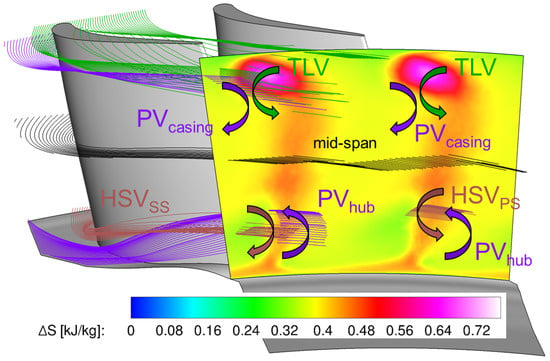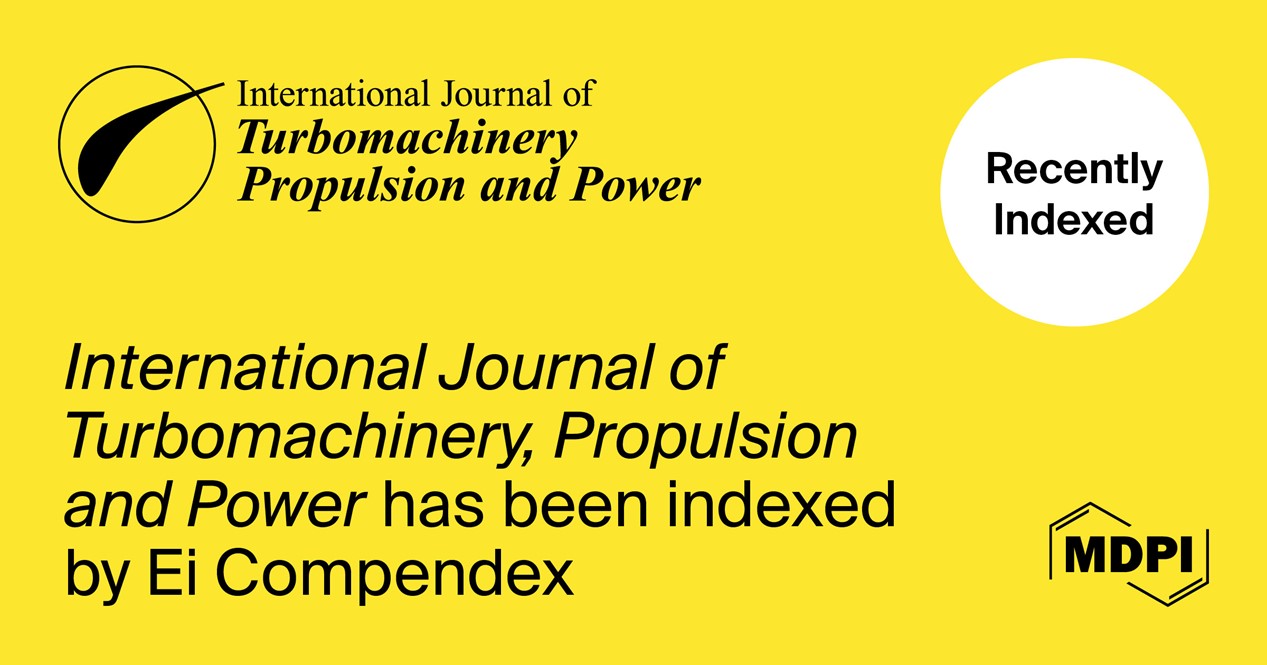Journal Description
International Journal of Turbomachinery, Propulsion and Power
International Journal of Turbomachinery, Propulsion and Power
is an international, peer-reviewed, open access journal on turbomachinery, propulsion and power. The journal is owned by the EUROTURBO European turbomachinery society and is published quarterly online by MDPI.
- Open Access— free for readers, with article processing charges (APC) paid by authors or their institutions.
- High Visibility: indexed within Scopus, ESCI (Web of Science), Inspec, and other databases.
- Rapid Publication: manuscripts are peer-reviewed and a first decision is provided to authors approximately 12 days after submission; acceptance to publication is undertaken in 19.6 days (median values for papers published in this journal in the second half of 2023).
- Recognition of Reviewers: reviewers who provide timely, thorough peer-review reports receive vouchers entitling them to a discount on the APC of their next publication in any MDPI journal, in appreciation of the work done.
Impact Factor:
1.4 (2022);
5-Year Impact Factor:
1.3 (2022)
Latest Articles
Unsteady Flows and Component Interaction in Turbomachinery
Int. J. Turbomach. Propuls. Power 2024, 9(2), 15; https://doi.org/10.3390/ijtpp9020015 - 05 Apr 2024
Abstract
Unsteady component interaction represents a crucial topic in turbomachinery design and analysis. Combustor/turbine interaction is one of the most widely studied topics both using experimental and numerical methods due to the risk of failure of high-pressure turbine blades by unexpected deviation of hot
[...] Read more.
Unsteady component interaction represents a crucial topic in turbomachinery design and analysis. Combustor/turbine interaction is one of the most widely studied topics both using experimental and numerical methods due to the risk of failure of high-pressure turbine blades by unexpected deviation of hot flow trajectory and local heat transfer characteristics. Compressor/combustor interaction is also of interest since it has been demonstrated that, under certain conditions, a non-uniform flow field feeds the primary zone of the combustor where the high-pressure compressor blade passing frequency can be clearly individuated. At the integral scale, the relative motion between vanes and blades in compressor and turbine stages governs the aerothermal performance of the gas turbine, especially in the presence of shocks. At the inertial scale, high turbulence levels generated in the combustion chamber govern wall heat transfer in the high-pressure turbine stage, and wakes generated by low-pressure turbine vanes interact with separation bubbles at low-Reynolds conditions by suppressing them. The necessity to correctly analyze these phenomena obliges the scientific community, the industry, and public funding bodies to cooperate and continuously build new test rigs equipped with highly accurate instrumentation to account for real machine effects. In computational fluid dynamics, researchers developed fast and reliable methods to analyze unsteady blade-row interaction in the case of uneven blade count conditions as well as component interaction by using different closures for turbulence in each domain using high-performance computing. This research effort results in countless publications that contribute to unveiling the actual behavior of turbomachinery flow. However, the great number of publications also results in fragmented information that risks being useless in a practical situation. Therefore, it is useful to collect the most relevant outcomes and derive general conclusions that may help the design of next-gen turbomachines. In fact, the necessity to meet the emission limits defined by the Paris agreement in 2015 obliges the turbomachinery community to consider revolutionary cycles in which component interaction plays a crucial role. In the present paper, the authors try to summarize almost 40 years of experimental and numerical research in the component interaction field, aiming at both providing a comprehensive overview and defining the most relevant conclusions obtained in this demanding research field.
Full article
(This article belongs to the Special Issue Advances in Critical Aspects of Turbomachinery Components and Systems)
►
Show Figures
Open AccessArticle
Relationship between Casing Pressure and Non-Synchronous Vibration in an Axial Compressor
by
Valerie Hernley, Aleksandar Jemcov, Jeongseek Kang, Matthew Montgomery and Scott C. Morris
Int. J. Turbomach. Propuls. Power 2024, 9(2), 14; https://doi.org/10.3390/ijtpp9020014 - 02 Apr 2024
Abstract
The relationship between aerodynamic forcing and non-synchronous vibration (NSV) in axial compressors remains difficult to ascertain from experimental measurements. In this work, the relationship between casing pressure and blade vibration was investigated using experimental observations from a 1.5-stage axial compressor under off-design conditions.
[...] Read more.
The relationship between aerodynamic forcing and non-synchronous vibration (NSV) in axial compressors remains difficult to ascertain from experimental measurements. In this work, the relationship between casing pressure and blade vibration was investigated using experimental observations from a 1.5-stage axial compressor under off-design conditions. The wavenumber-dependent auto-spectral density (ASD) of casing pressure was introduced to aid in understanding the characteristics of pressure fluctuations that lead to the aeromechanical response. Specifically, the rotor blade’s natural frequencies and nodal diameters could be directly compared with the pressure spectra. This analysis indicated that the rotating disturbances coincided with the first bending (1B) and second bending (2B) vibration modes at certain frequencies and wavenumbers. The non-intrusive stress measurement system (NSMS) data showed elevated vibration amplitudes for the coincident nodal diameters. The amplitude of the wavenumber-dependent pressure spectra was projected onto the single-degree-of-freedom (SDOF) transfer function and was compared with the measured vibration amplitude. The results showed a near-linear relationship between the pressure and vibration data.
Full article
(This article belongs to the Special Issue Selected Papers from the 16th International Symposium on Unsteady Aerodynamics, Aeroacoustics and Aeroelasticity of Turbomachines (ISUAAAT16))
►▼
Show Figures

Figure 1
Open AccessFeature PaperArticle
Numerical and Experimental Study of Flutter in a Realistic Labyrinth Seal
by
Oscar Bermejo, Juan Manuel Gallardo, Adrian Sotillo, Arnau Altuna, Roberto Alonso and Andoni Puente
Int. J. Turbomach. Propuls. Power 2024, 9(2), 13; https://doi.org/10.3390/ijtpp9020013 - 01 Apr 2024
Abstract
Labyrinth seals are commonly used in turbomachinery in order to control leakage flows. Flutter is one of the most dangerous potential issues for them, leading to High Cycle Fatigue (HCF) life considerations or even mechanical failure. This phenomenon depends on the interaction between
[...] Read more.
Labyrinth seals are commonly used in turbomachinery in order to control leakage flows. Flutter is one of the most dangerous potential issues for them, leading to High Cycle Fatigue (HCF) life considerations or even mechanical failure. This phenomenon depends on the interaction between aerodynamics and structural dynamics; mainly due to the very high uncertainties regarding the details of the fluid flow through the component, it is very hard to predict accurately. In 2014, as part of the E-Break research project funded by the European Union (EU), an experimental campaign regarding the flutter behaviour of labyrinth seals was conducted at “Centro de Tecnologias Aeronauticas” (CTA). During this campaign, three realistic seals were tested at different rotational speeds, and the pressure ratio where the flutter onset appeared was determined. The test was reproduced using a linearised uncoupled structural-fluid methodology of analysis based on Computational Fluid Dynamics (CFD) simulations, with results only in moderate agreement with experimental data. A procedure to adjust the CFD simulations to the steady flow measurements was developed. Once this method was applied, the matching between flutter predictions and the measured data improved, but some discrepancies could still be found. Finally, a set of simulations to retain the influence of the external cavities was run, which further improved the agreement with the testing data.
Full article
(This article belongs to the Special Issue Selected Papers from the 16th International Symposium on Unsteady Aerodynamics, Aeroacoustics and Aeroelasticity of Turbomachines (ISUAAAT16))
►▼
Show Figures
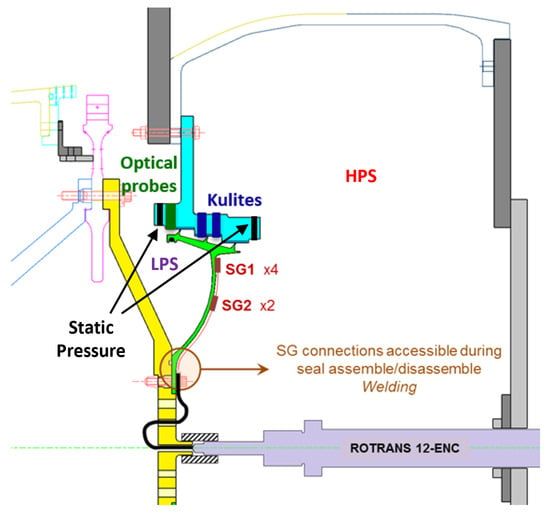
Figure 1
Open AccessFeature PaperArticle
Modelling Method for Aeroelastic Low Engine Order Excitation Originating from Upstream Vanes’ Geometrical Variability
by
Marco Gambitta, Bernd Beirow and Sven Schrape
Int. J. Turbomach. Propuls. Power 2024, 9(2), 12; https://doi.org/10.3390/ijtpp9020012 - 01 Apr 2024
Abstract
The manufacturing geometrical variability in axial compressors is a stochastic source of uncertainty, implying that the real geometry differs from the nominal design. This causes the real geometry to lose the ideal axial symmetry. Considering the aerofoils of a stator vane, the geometrical
[...] Read more.
The manufacturing geometrical variability in axial compressors is a stochastic source of uncertainty, implying that the real geometry differs from the nominal design. This causes the real geometry to lose the ideal axial symmetry. Considering the aerofoils of a stator vane, the geometrical variability affects the flow traversing it. This impacts the downstream rotor, especially when considering the aeroelastic excitation forces. Optical surface scans coupled with a parametrisation method allow for acquiring the information relative to the real aerofoils geometries. The measured data are included in a multi-passage and multi-stage CFD setup to represent the mistuned flow. In particular, low excitation harmonics on the rotor vane are introduced due to the geometrical deviations of the upstream stator. The introduced low engine orders, as well as their amplitude, depend on the stator geometries and their order. A method is proposed to represent the phenomena in a reduced CFD domain, limiting the size and number of solutions required to probabilistically describe the rotor excitation forces. The resulting rotor excitation forces are reconstructed as a superposition of disturbances due to individual stator aerofoils geometries. This indicates that the problem is linear in the combination of disturbances from single passages.
Full article
(This article belongs to the Special Issue Selected Papers from the 16th International Symposium on Unsteady Aerodynamics, Aeroacoustics and Aeroelasticity of Turbomachines (ISUAAAT16))
►▼
Show Figures
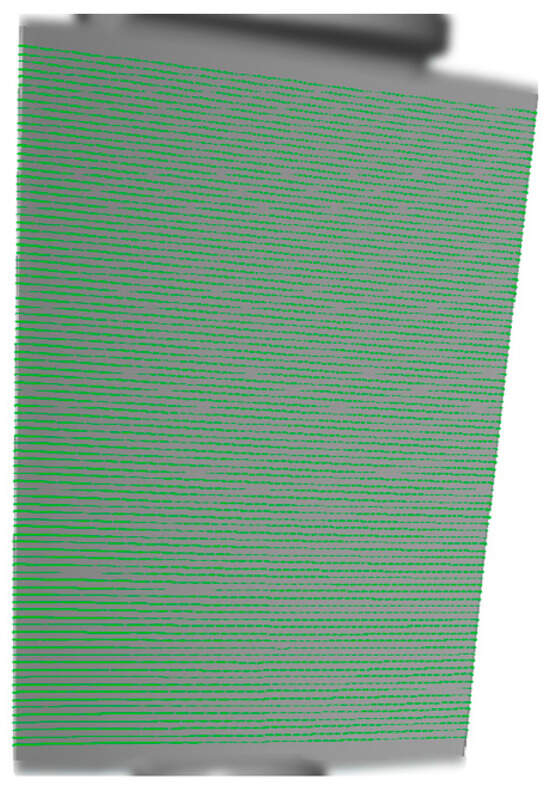
Figure 1
Open AccessFeature PaperReview
Turbomachinery Noise Review
by
Stéphane Moreau and Michel Roger
Int. J. Turbomach. Propuls. Power 2024, 9(1), 11; https://doi.org/10.3390/ijtpp9010011 - 13 Mar 2024
Abstract
The present paper is aimed at providing an updated review of prediction methods for the aerodynamic noise of ducted rotor–stator stages. Indeed, ducted rotating-blade technologies are in continuous evolution and are increasingly used for aeronautical propulsion units, power generation and air conditioning systems.
[...] Read more.
The present paper is aimed at providing an updated review of prediction methods for the aerodynamic noise of ducted rotor–stator stages. Indeed, ducted rotating-blade technologies are in continuous evolution and are increasingly used for aeronautical propulsion units, power generation and air conditioning systems. Different needs are faced from the early design stage to the final definition of a machine. Fast-running, approximate analytical approaches and high-fidelity numerical simulations are considered the best-suited tools for each, respectively. Recent advances are discussed, with emphasis on their pros and cons.
Full article
(This article belongs to the Special Issue Advances in Critical Aspects of Turbomachinery Components and Systems)
►▼
Show Figures
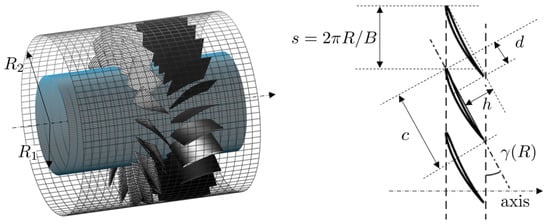
Figure 1
Open AccessFeature PaperArticle
Quantification of Blade Vibration Amplitude in Turbomachinery
by
Alexandra P. Schneider, Benoit Paoletti, Xavier Ottavy and Christoph Brandstetter
Int. J. Turbomach. Propuls. Power 2024, 9(1), 10; https://doi.org/10.3390/ijtpp9010010 - 04 Mar 2024
Abstract
Experimental monitoring of blade vibration in turbomachinery is typically based on blade-mounted strain gauges. Their signals are used to derive vibration amplitudes which are compared to modal scope limits, including a safety factor. According to industrial guidelines, this factor is chosen conservatively to
[...] Read more.
Experimental monitoring of blade vibration in turbomachinery is typically based on blade-mounted strain gauges. Their signals are used to derive vibration amplitudes which are compared to modal scope limits, including a safety factor. According to industrial guidelines, this factor is chosen conservatively to ensure safe operation of the machine. Within the experimental campaign with the open-test-case composite fan ECL5/CATANA, which is representative for modern lightweight Ultra High Bypass Ratio (UHBR) architectures, measurements close to the stability limit have been conducted. Investigation of phenomena like non-synchronous vibrations (NSV) and rotating stall require a close approach to the stability limit and hence demand for accurate (real-time) quantification of vibration amplitudes to ensure secure operation without exhaustive safety margins. Historically, short-time Fourier transforms of vibration sensors are used, but the complex nature of the mentioned coupled phenomena has an influence on amplitude accuracy, depending on evaluation parameters, as presented in a previous study using fast-response wall-pressure transducers. The present study investigates the sensitivity of blade vibration data to evaluation parameters for different spectral analysis methods and provides guidelines for fast and robust surveillance of critical vibration modes.
Full article
(This article belongs to the Special Issue Selected Papers from the XXVI Biennial Symposium on Measuring Techniques in Turbomachinery)
►▼
Show Figures

Graphical abstract
Open AccessArticle
Low-Noise Airfoils for Turbomachinery Applications: Two Examples of Optimization
by
Nicola Casari, Ettore Fadiga, Stefano Oliani, Mattia Piovan, Michele Pinelli and Alessio Suman
Int. J. Turbomach. Propuls. Power 2024, 9(1), 9; https://doi.org/10.3390/ijtpp9010009 - 02 Mar 2024
Abstract
►▼
Show Figures
Automotive fans, small wind turbines, and manned and unmanned aerial vehicles (MAVs/UAVs) are just a few examples in which noise generated by the flow’s interaction with aerodynamic surfaces is a major concern. The current work shows the potential of a new airfoil shape
[...] Read more.
Automotive fans, small wind turbines, and manned and unmanned aerial vehicles (MAVs/UAVs) are just a few examples in which noise generated by the flow’s interaction with aerodynamic surfaces is a major concern. The current work shows the potential of a new airfoil shape to minimize noise generation, maintaining a high lift-to-drag ratio in a prescribed Reynolds regime. This investigation uses a multifidelity approach: a low-fidelity semiempirical model is exploited to evaluate the sound pressure level (SPL). Fast evaluation of a low-cost function enables the computation of a large range of possible profiles, and accuracy is added to the low-fidelity response surface with high-fidelity CFD data. The constraint of maintaining a predefined range of the lift coefficient and lift-to-drag ratio ensures the possibility of using this profile in usual design procedures.
Full article

Figure 1
Open AccessFeature PaperArticle
Numerical and Experimental Investigations on the Acoustic Characteristics of a Single-Stage Centrifugal Pump
by
Christian Lehr, Pascal Munsch, Romuald Skoda and Andreas Brümmer
Int. J. Turbomach. Propuls. Power 2024, 9(1), 8; https://doi.org/10.3390/ijtpp9010008 - 01 Mar 2024
Abstract
►▼
Show Figures
The acoustic properties of a single-stage centrifugal pump with low specific speed are investigated by means of compressible 3D CFD simulations (URANS) and experiments. In order to determine the pump’s acoustic transmission and excitation characteristics, a four-pole approach in the frequency domain is
[...] Read more.
The acoustic properties of a single-stage centrifugal pump with low specific speed are investigated by means of compressible 3D CFD simulations (URANS) and experiments. In order to determine the pump’s acoustic transmission and excitation characteristics, a four-pole approach in the frequency domain is used. The transmission parameters determined by simulation are compared to experiments in water and air as functions of the Helmholtz number. The results indicate that the acoustic transmission characteristics within the experiments are significantly influenced by the structural compliance of the volute casing in terms of a fluid–structure interaction (FSI). A modelling approach for a one-dimensional representation of the centrifugal pump’s acoustic transmission characteristics in the time and frequency domains is applied to the current pump. As one model parameter, the effective speed of sound in the 1D model needs to be reduced to 607

Figure 1
Open AccessArticle
Multidisciplinary Automation in Design of Turbine Vane Cooling Channels
by
Sanjay Nambiar, Anan Ashrabi Ananno, Herman Titus, Anton Wiberg and Mehdi Tarkian
Int. J. Turbomach. Propuls. Power 2024, 9(1), 7; https://doi.org/10.3390/ijtpp9010007 - 19 Feb 2024
Abstract
►▼
Show Figures
In the quest to enhance the efficiency of gas turbines, there is a growing demand for innovative solutions to optimize high-pressure turbine blade cooling. However, the traditional methods for achieving this optimization are known for their complexity and time-consuming nature. We present an
[...] Read more.
In the quest to enhance the efficiency of gas turbines, there is a growing demand for innovative solutions to optimize high-pressure turbine blade cooling. However, the traditional methods for achieving this optimization are known for their complexity and time-consuming nature. We present an automation framework to streamline the design, meshing, and structural analysis of cooling channels, achieving design automation at both the morphological and topological levels. This framework offers a comprehensive approach for evaluating turbine blade lifetime and enabling multidisciplinary design analyses, emphasizing flexibility in turbine cooling design through high-level CAD templates and knowledge-based engineering. The streamlined automation process, supported by a knowledge base, ensures continuity in both the mesh and structural simulation automations, contributing significantly to advancements in gas turbine technology.
Full article
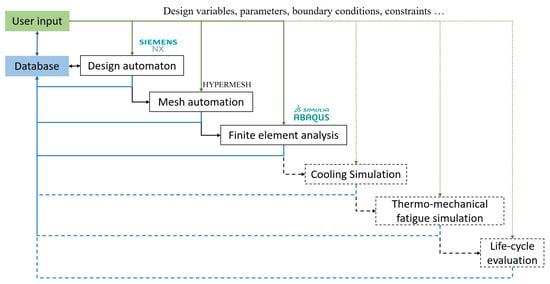
Figure 1
Open AccessArticle
Genetic Algorithm-Based Optimisation of a Double-Wall Effusion Cooling System for a High-Pressure Turbine Nozzle Guide Vane
by
Michael van de Noort and Peter T. Ireland
Int. J. Turbomach. Propuls. Power 2024, 9(1), 6; https://doi.org/10.3390/ijtpp9010006 - 02 Feb 2024
Abstract
►▼
Show Figures
Double-Wall Effusion Cooling schemes present an opportunity for aeroengine designers to achieve high overall cooling effectiveness and convective cooling efficiency in High-Pressure Turbine blades with reduced coolant usage compared to conventional cooling technologies. This is accomplished by combining impingement, pin-fin and effusion cooling.
[...] Read more.
Double-Wall Effusion Cooling schemes present an opportunity for aeroengine designers to achieve high overall cooling effectiveness and convective cooling efficiency in High-Pressure Turbine blades with reduced coolant usage compared to conventional cooling technologies. This is accomplished by combining impingement, pin-fin and effusion cooling. Optimising these cooling schemes is crucial to ensuring that cooling is achieved sufficiently at high-heat-flux regions and not overused at low-heat-flux ones. Due to the high number of design variables employed in these systems, optimisation through the use of Computational Fluid Dynamics (CFD) simulations can be a computationally costly and time-consuming process. This study makes use of a Low-Order Flow Network Model (LOM), developed, validated and presented previously, which quickly assesses the pressure, temperature, mass flow and heat flow distributions through a Double-Wall Effusion Cooling scheme. Results generated by the LOM are used to rapidly produce an ideal cooling system design through the use of an Evolutionary Genetic Algorithm (GA) optimisation process. The objective is to minimise the coolant mass flow whilst maintaining acceptable metal cooling effectiveness around the external surface of the blade and ensuring that the Backflow Margin for all film holes is above a selected threshold. For comparison, a Genetic Aggregation model-based optimisation using CFD simulations in ANSYS Workbench is also conducted. Results for both the reduction of coolant mass flow and the total optimisation runtime are analysed alongside those from the LOM, demonstrating the benefit of rapid low-order solving techniques.
Full article
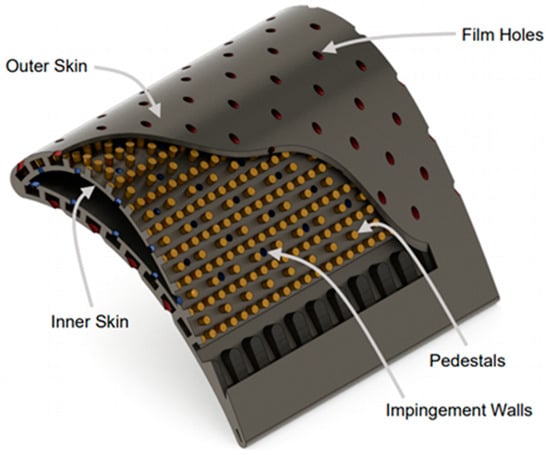
Figure 1
Open AccessArticle
Design of a 130 MW Axial Turbine Operating with a Supercritical Carbon Dioxide Mixture for the SCARABEUS Project
by
Abdelrahman S. Abdeldayem, Salma I. Salah, Omar A. Aqel, Martin T. White and Abdulnaser I. Sayma
Int. J. Turbomach. Propuls. Power 2024, 9(1), 5; https://doi.org/10.3390/ijtpp9010005 - 02 Feb 2024
Cited by 1
Abstract
►▼
Show Figures
Supercritical carbon dioxide (sCO2) can be mixed with dopants such as titanium tetrachloride (TiCl4), hexafluoro-benzene (C6F6), and sulphur dioxide (SO2) to raise the critical temperature of the working fluid, allowing it to condense
[...] Read more.
Supercritical carbon dioxide (sCO2) can be mixed with dopants such as titanium tetrachloride (TiCl4), hexafluoro-benzene (C6F6), and sulphur dioxide (SO2) to raise the critical temperature of the working fluid, allowing it to condense at ambient temperatures in dry solar field locations. The resulting transcritical power cycles have lower compression work and higher thermal efficiency. This paper presents the aerodynamic flow path design of a utility-scale axial turbine operating with an 80–20% molar mix of CO2 and SO2. The preliminary design is obtained using a mean line turbine design method based on the Aungier loss model, which considers both mechanical and rotor dynamic criteria. Furthermore, steady-state 3D computational fluid dynamic (CFD) simulations are set up using the k-ω SST turbulence model, and blade shape optimisation is carried out to improve the preliminary design while maintaining acceptable stress levels. It was found that increasing the number of stages from 4 to 14 increased the total-to-total efficiency by 6.3% due to the higher blade aspect ratio, which reduced the influence of secondary flow losses, as well as the smaller tip diameter, which minimised the tip clearance losses. The final turbine design had a total-to-total efficiency of 92.9%, as predicted by the CFD results, with a maximum stress of less than 260 MPa and a mass flow rate within 1% of the intended cycle’s mass flow rate. Optimum aerodynamic performance was achieved with a 14-stage design where the hub radius and the flow path length are 310 mm and 1800 mm, respectively. Off-design analysis showed that the turbine could operate down to 88% of the design reduced mass flow rate with a total-to-total efficiency of 80%.
Full article

Figure 1
Open AccessArticle
Turbulence Measurements Downstream of a Combustor Simulator Designed for Studies on the Combustor–Turbine Interaction
by
Andrea Notaristefano, Giacomo Persico and Paolo Gaetani
Int. J. Turbomach. Propuls. Power 2024, 9(1), 4; https://doi.org/10.3390/ijtpp9010004 - 10 Jan 2024
Cited by 1
Abstract
►▼
Show Figures
Turbulence intensity impacts the performance of turbine stages and it is an important inlet boundary condition for CFD computations; the knowledge of its value at the turbine inlet is then of paramount importance. In combustor–turbine interaction experimental studies, combustor simulators replace real combustors
[...] Read more.
Turbulence intensity impacts the performance of turbine stages and it is an important inlet boundary condition for CFD computations; the knowledge of its value at the turbine inlet is then of paramount importance. In combustor–turbine interaction experimental studies, combustor simulators replace real combustors and allow for the introduction of flow perturbation at the turbine inlet. Therefore, the turbulence intensity of a combustor simulator used in a wide experimental campaign at Politecnico di Milano is characterized using a hot-wire probe in a blow-down wind tunnel, and the results are compared to URANS CFD computations. This combustor simulator can generate a combination of a swirl profile with a steady/unsteady temperature disturbance. In the cold unsteady disturbance case, hot-wire measurements are phase-averaged at the frequency of the injected perturbation. The combustor simulator turbulence intensity is measured at two different axial positions to understand its evolution.
Full article
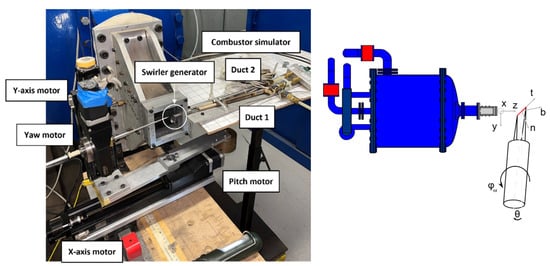
Figure 1
Open AccessFeature PaperArticle
An Experimental Database for the Analysis of Bursting of a Laminar Separation Bubble
by
Matteo Dellacasagrande, Davide Lengani, Daniele Simoni and Marina Ubaldi
Int. J. Turbomach. Propuls. Power 2024, 9(1), 3; https://doi.org/10.3390/ijtpp9010003 - 10 Jan 2024
Abstract
►▼
Show Figures
The bursting phenomenon consists in the switch of a laminar separation bubble from a short to a long configuration. In the former case, reduced effects on profile pressure distribution are typically observed with respect to the attached condition. On the contrary, long bubbles
[...] Read more.
The bursting phenomenon consists in the switch of a laminar separation bubble from a short to a long configuration. In the former case, reduced effects on profile pressure distribution are typically observed with respect to the attached condition. On the contrary, long bubbles provoke significant variations in the loading coefficient upstream of the separation position, with increased risk of stall of the lifting surfaces. The present work presents an experimental database describing separated boundary layers evolving under different Reynolds numbers, adverse pressure gradients and free-stream turbulence levels. Overall, more than 80 flow conditions were tested concerning short and long bubbles for the characterization of separated flows under turbine-like conditions. Measurements were performed on a flat plate geometry using a fast-response Particle Image Velocimetry (PIV) system. For each flow case, two sets of 6000 flow records were acquired with an acquisition frequency equal to 300 and 1000 Hz. Based on existing criteria for the identification of the bursting phenomenon, the flow cases were clustered in terms of short and long bubble states. Additionally, the kind of instability (i.e., convective or absolute) developing into the separated boundary layer was identified based on flow statistics. The present data captures the existing link between the bursting of a laminar separation bubble and the onset of the absolute instability of the separated shear layer, with stationary vortices forming in the dead air region.
Full article
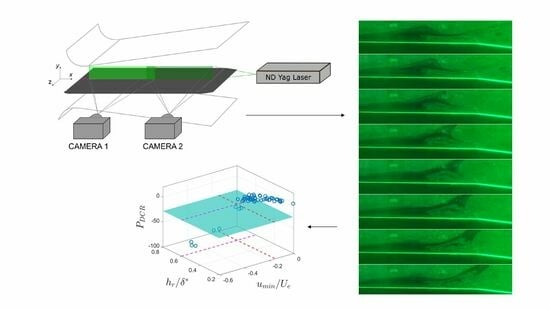
Graphical abstract
Open AccessArticle
Comparison Study of the k − kL − ω and γ − Reθ Transition Model in the Open-Water Performance Prediction of a Rim-Driven Thruster
by
Bao Liu, Maarten Vanierschot and Frank Buysschaert
Int. J. Turbomach. Propuls. Power 2024, 9(1), 2; https://doi.org/10.3390/ijtpp9010002 - 09 Jan 2024
Abstract
The present work examines the capabilities of two transition models implemented in ANSYS Fluent in the open-water performance prediction of a rim-driven thruster (RDT). The adopted models are the three-equation
The present work examines the capabilities of two transition models implemented in ANSYS Fluent in the open-water performance prediction of a rim-driven thruster (RDT). The adopted models are the three-equation
(This article belongs to the Special Issue Selected Turbomachinery Papers from the 18th Conference on Modelling Fluid Flow CMFF'22)
►▼
Show Figures

Figure 1
Open AccessFeature PaperArticle
Effect of Leading-Edge Erosion on the Performance of Transonic Compressor Blades
by
Alexander Hergt, Tobias Danninger, Joachim Klinner, Sebastian Grund, Manfred Beversdorff and Christian Werner-Spatz
Int. J. Turbomach. Propuls. Power 2024, 9(1), 1; https://doi.org/10.3390/ijtpp9010001 - 09 Jan 2024
Abstract
►▼
Show Figures
In this paper, an experimental and numerical investigation of the effect of leading-edge erosion in transonic blades was performed. The measurements were carried out on a linear blade cascade in the Transonic Cascade Wind Tunnel of DLR in Cologne at two operating points
[...] Read more.
In this paper, an experimental and numerical investigation of the effect of leading-edge erosion in transonic blades was performed. The measurements were carried out on a linear blade cascade in the Transonic Cascade Wind Tunnel of DLR in Cologne at two operating points with an inflow Mach number of 1.05 and 1.12. The numerical simulations were performed by ANSYS Germany. The type and specifications of the erosion for the study were derived from real engine blades and applied to the leading edges of the experimental cascade blades using a waterjet process, as well as modeled in detail and meshed within the numerical setup. Numerical simulations and extensive wake measurements were carried out on the cascades to evaluate the aerodynamic performance. The increase in losses was quantified to be 4 percent, and a reduction in deflection and a rise in pressure were detected at both operating points.
Full article

Figure 1
Open AccessArticle
A Comparison of Steam Turbine Control Valve Geometries and Their Dynamic Behavior at Part Load
by
Christian Windemuth, Martin Lange and Ronald Mailach
Int. J. Turbomach. Propuls. Power 2023, 8(4), 55; https://doi.org/10.3390/ijtpp8040055 - 18 Dec 2023
Abstract
►▼
Show Figures
A growing significance of flexible steam turbine operation challenges the control of turbines, as part load operation using control valves can be accompanied by highly unsteady flow conditions. The increased dynamic load induced by pressure forces can reduce the reliable operating range, weaken
[...] Read more.
A growing significance of flexible steam turbine operation challenges the control of turbines, as part load operation using control valves can be accompanied by highly unsteady flow conditions. The increased dynamic load induced by pressure forces can reduce the reliable operating range, weaken the valve, and lead to mechanical failures. The geometry of the valve plays a major role in the reduction of dynamic forces. Using a scaled control valve, experiments were conducted with a focus on the dynamic behavior of the valve head. A spherical valve shape favoring unstable operation was used as a reference case, and the desired instability was proven by measurements. Different modified valve geometries based on literature featuring separation edges were then tested against the spherical shape. Results indicate the improved stability of the modified geometries over the reference geometry. For most of the operating range, vibrations were drastically reduced, and the overall flow stabilized.
Full article

Figure 1
Open AccessFeature PaperArticle
NREL-5MW Wind Turbine Noise Prediction by FWH-LES
by
Claudio Bernardi, Federico Porcacchia, Claudio Testa, Pietro De Palma, Stefano Leonardi and Stefania Cherubini
Int. J. Turbomach. Propuls. Power 2023, 8(4), 54; https://doi.org/10.3390/ijtpp8040054 - 06 Dec 2023
Abstract
►▼
Show Figures
This paper deals with large onshore wind turbine aeroacoustics. Noise from the NREL 5 MW device is predicted by the permeable-surface Ffowcs Williams–Hawkings equation (FWH-P), starting from the postprocessing of LES data on different acoustic surfaces
This paper deals with large onshore wind turbine aeroacoustics. Noise from the NREL 5 MW device is predicted by the permeable-surface Ffowcs Williams–Hawkings equation (FWH-P), starting from the postprocessing of LES data on different acoustic surfaces

Figure 1
Open AccessArticle
Fan Stage Design and Performance Optimization for Low Specific Thrust Turbofans
by
Oliver Sjögren, Tomas Grönstedt, Anders Lundbladh and Carlos Xisto
Int. J. Turbomach. Propuls. Power 2023, 8(4), 53; https://doi.org/10.3390/ijtpp8040053 - 04 Dec 2023
Abstract
►▼
Show Figures
In modern turbofan engines, the bypass section of the fan stage alone provides the majority of the total thrust required in cruise, and the size of the fan has a considerable effect on the overall engine weight and nacelle drag. Thrust requirements in
[...] Read more.
In modern turbofan engines, the bypass section of the fan stage alone provides the majority of the total thrust required in cruise, and the size of the fan has a considerable effect on the overall engine weight and nacelle drag. Thrust requirements in different parts of the flight envelope must also be satisfied together with sufficient margins towards stalling. An accurate description of the interdependencies between the relevant performance and design attributes of the fan stage alone—such as efficiency, surge margin, fan-face Mach number, stage loading, flow coefficient, and aspect ratio—are therefore necessary to estimate system-level objectives such as mission fuel burn and the direct operating cost with enough confidence during the conceptual design phase. The contribution of this study is to apply a parametric optimization approach to the conceptual design of fan stages for low specific thrust turbofans based on the streamline curvature method. Trade-offs between fan stage attributes for Pareto-optimal solutions are modeled by training Kriging surrogate models on the results from the parametric optimization. A case study is provided in the end to demonstrate the potential implications of including a higher level of fan-stage parameter interdependency in an engine systems model. Results implied that being able to predict the rotor solidity required to maintain a given average blade loading—in addition to stage efficiency—is of significant importance when it comes to evaluating the trade-off between engine weight and thrust-specific fuel consumption.
Full article
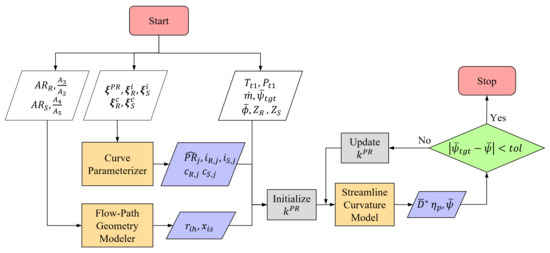
Figure 1
Open AccessArticle
Numerical Modelling of the 3D Unsteady Flow of an Inlet Particle Separator for Turboshaft Engines
by
Marco Castaldi, Ignacio Mayo, Jacques Demolis and Frank Eulitz
Int. J. Turbomach. Propuls. Power 2023, 8(4), 52; https://doi.org/10.3390/ijtpp8040052 - 04 Dec 2023
Abstract
►▼
Show Figures
Helicopter and turboprop engines are susceptible to the ingestion of debris and other foreign objects, especially during take-off, landing, and hover. To avoid deleterious effects, filters such as Inlet Particle Separators (IPS) can be installed. However, the performance and limitations of these systems
[...] Read more.
Helicopter and turboprop engines are susceptible to the ingestion of debris and other foreign objects, especially during take-off, landing, and hover. To avoid deleterious effects, filters such as Inlet Particle Separators (IPS) can be installed. However, the performance and limitations of these systems have to be investigated before the actual equipment can be installed in the aircraft powerplant. In this paper, we propose different numerical methods with increasing resolution in order to provide an aerodynamic characterization of the IPS, i.e., from a simple semi-empirical model to 3D large eddy simulation. We validate these numerical tools that could aid IPS design using experimental data in terms of global parameters such as separation efficiency and pressure losses. For each of those tools, we underline weaknesses and potential benefits in industry practices. Unsteady flow analysis reveals that detached eddy simulation is the trade-off choice that allows designers to most effectively plan experimental campaigns and mitigate risks.
Full article

Figure 1
Open AccessArticle
Profile Loss Prediction for Organic Rankine Cycle Turbines: An Experimental Case Study
by
Leander Hake, Stephan Sundermeier and Stefan aus der Wiesche
Int. J. Turbomach. Propuls. Power 2023, 8(4), 51; https://doi.org/10.3390/ijtpp8040051 - 01 Dec 2023
Abstract
►▼
Show Figures
The results of profile loss measurements, including trailing edge flow details, are presented for the flow of an organic vapor through a linear turbine cascade. The so-called VKI-I blade profile from the open literature was chosen for the cascade, and the working fluid
[...] Read more.
The results of profile loss measurements, including trailing edge flow details, are presented for the flow of an organic vapor through a linear turbine cascade. The so-called VKI-I blade profile from the open literature was chosen for the cascade, and the working fluid was NOVEC 649. Pitot probes and hot-wire anemometry were employed to measure the flow field up and downstream of the cascade. Details of the unsteady flow caused by the trailing edge of the blades and the turbulent spectrum were investigated using hot-wire anemometry. The new organic vapor flow results were compared with the literature data obtained for air and with the prediction of conventional literature loss models. It was found that, under certain thermodynamic conditions, specific traditional loss models can reasonably predict organic Rankine cycle (ORC) turbines’ profile loss. Still, significant deviations between the loss models and the experimental data can also occur.
Full article
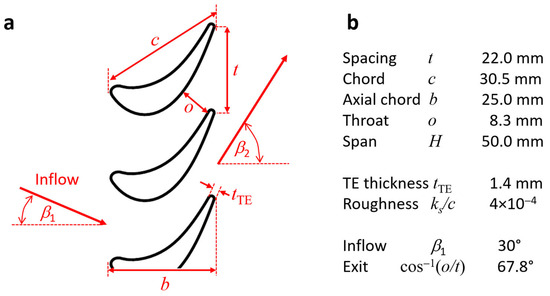
Figure 1
Highly Accessed Articles
Latest Books
E-Mail Alert
News
Topics




